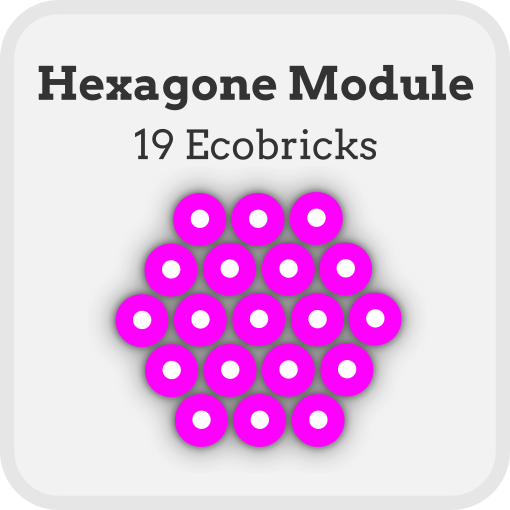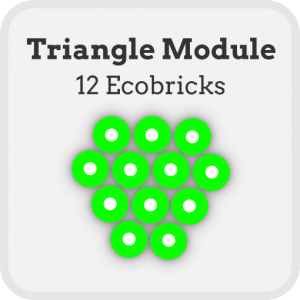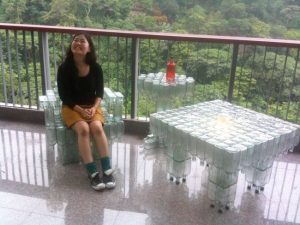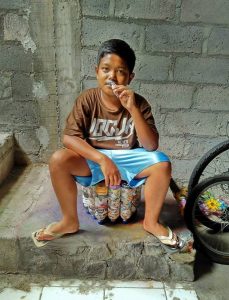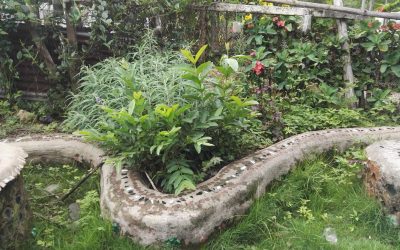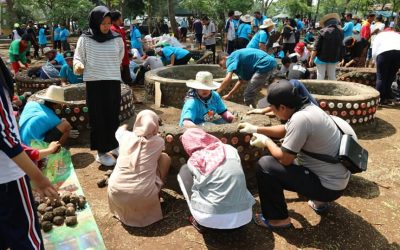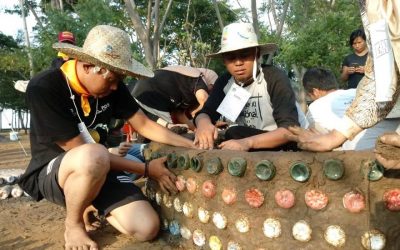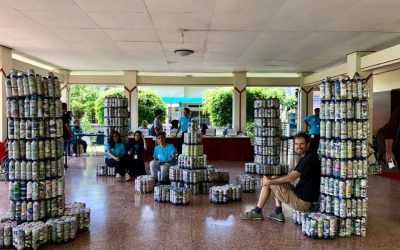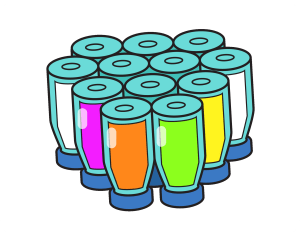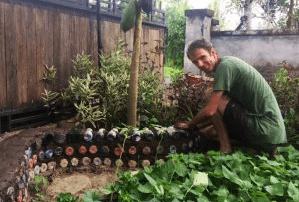Surely, one of the emblems of our age is the bottle. Billions of them flood the land and sea as corporations exploit plastic and glass to bring us beverages we don’t really need. Milstein Modules are a simple, low cost innovation, to put this abundance of bottles to use… locally and globally, for the people and the planet.
 There are two main types of Milstein modules: triangles and hexagons. Milstein Modules can be used individually as seats or combined hexagon to hexagon, or triangle to hexagon, to create two dimensional horizontal surfaces like tables, beds, benches and more. To make the modules we use silicone sealant. Silicone is different from plastic (it doesn’t degrade into toxins) yet it bonds ecobricks, PET bottles, and glass bottles strongly together.
There are two main types of Milstein modules: triangles and hexagons. Milstein Modules can be used individually as seats or combined hexagon to hexagon, or triangle to hexagon, to create two dimensional horizontal surfaces like tables, beds, benches and more. To make the modules we use silicone sealant. Silicone is different from plastic (it doesn’t degrade into toxins) yet it bonds ecobricks, PET bottles, and glass bottles strongly together.
Milstein Modules are named after the American teacher of peace, Dan Milstein, who passed away in 2015. Dan was one of the pioneering supporters of my work with ecobricks, which lead to the discovery and refinement of the Milstein Module.
Hexagon Modules
Triangle Modules
Glass Bottle Modules
Making Milstein Modules
The Story
The story begins in the Northern Philippines, in a small indigenous village where I was stranded for four years. In the Philippines, people like to drink gin. Like… A LOT. In these remote villages, there is simply was no way to dispose of the empty bottles. They pile up. Often, you’ll find piles of hundreds, even thousands of the bottles tucked in trash piles, under people’s houses, and stashed in forests.
I had managed to find an amazing space to call my home in one of the villages. It was basically a loft, with hard wood floors, overlooking the spectacular river valley (rent: 30$ a month!). The only problem: No furniture! And… no way to get furniture for hundreds of kilometres. I needed to furnish it somehow, so my girlfriend at the time, Bianca SIlva and I, started playing around with all these bottles. I used silicone, to join the bottles together to make a little stool. At first, I was doubtful it would hold our weight, or whether it would be strong enough. But… it was! Not only was it super strong and sturdy, it was actually comfortable.
I remember staring at the first one we made together, and thinking to myself, this is so beautiful and so use-full, people are going to love this!
The first furniture we made with glass bottles. The gin bottles in the Philippines are absolutely perfect for building stuff like this– the bottles are basically square and fit together easily. The outputs that you make with them are similarly square and rectangular. Later we began to make them with Ecobricks (plastic bottles packed with plastic waste). As the Ecobrick phenomenon has spread around South East Asia, so too has my invention spread, with this being one of the most practical ecobrick outputs.
Making it Modular
Notice that at this point, I haven’t called them “Milstein Modules”. That’s because I hadn’t need to move my bottle furniture yet. After two years in the village, it was time to go to the next place. I was keen to take my furniture out and share it with my neighbours and friends in the community. In particular I had a big couch that I had made with the gin bottles. It was about 250m x 70cm x 70cm. I got four strapping farmer boys, to help me lift it and take it out. But…
They couldn’t lift it!
We couldn’t get it out the door let alone down the stairs. In the end, the couch, despite all its coolness, it couldn’t find its next home. We literally had to take a hammer to it and shatter the bottles down the centre. We managed to split it into two couch chairs, and at least we could get those out.
Those hammer blows, echoed long after in my mind. How to build practical furniture from bottles? Furniture that, despite the weight and fragility of glass, could be moved. The solution came as we moved into using circular bottles in our bottle construction.
Circles, when combined, make hexagons and triangles! Hexagons fit together two dimensionally just like honey comb. While, three dimensionally Hexagons and triangles fit together just like LEGO.
Modular design fulfils the essential principle of Regenerative Design, that creations must be Cradle-to-Cradle. In other words, that the next life of the creation is built in, so that when the object comes to its end, it doesn’t have to be trashed, but can instead be reused over and over. Milstein modules, either in glass or plastic bottles, are just this at two levels: one you can build over and over with the modules them, and second, the silicone joining bond, is such that it can be cut with a knife– and the bottles them cycled out to be used as a brick for cob construction.
At this point Ecobricks had really taken off in the region where I was living. We had got it into the school system, and suddenly hundreds of schools had hundreds of ecobricks that they didn’t know quite what to do with. You can use ecobricks for outdoor cob constructions, but it takes hundreds or thousands of ecobricks, and more effort and coordination. We needed a quick and easy output for ecobrickers. It was then that I made my first Ecobrick Milstein module.
This time, we were using circular coke bottles to build with– so the result was hexagons! Hexagons, as you know, fit together to make honeycomb shapes real easy. The more hexagon modules a school made, the more cool stuff they could assemble! From chairs, to tables, to bigger tables, to stages! Students loved it.
Indonesian Viral Spread
I have brought the technique with me to Indonesia. Here, it has been the primary ecobrick output that we have encouraged (we’re getting back to cob garden building though!). The furniture modules are admittedly a jump for people to make and incorporate in their home and schools. There’s nothing like it in conventional furniture thinking (unless you’re really rich, and have some Italian modern art designer furniture!). But, the modules are just so practical that sure and steady, the technique has thus spread extensively.
My Blog Posts on Bottle Building
Balili Food Forest Play Park Six Years On
News and photos of the thriving earth and ecobrick garden I helped build with my friends in the Filipine Coordilleras
Earth & Ecobrick Mandala Park Build Final Phase
Our 33 trainers and 200 volunteers descended on our mandala earth and ecobrick park yesterday for the final phase of contruction It was a unique experience for me to relax through the completion and finishing stages of construction. Typically, when leading a build,...
Earth Building Workshop Day 3: Mandalic CollaborationTheory
Day three of our earth and ecobrick trainer course we went deep into mandalic collaboration theory with the full morning invested in making personal, partner, and group mandalas. I have been reflecting and preparing for how we would do this part of the workshop for...
Earth & Ecobrick Building Workshop
its been a full out last few days here in Probolingo, East Java as we launch our first official Earth and Ecobrick building course! We have thirty of our star trainers who have joined Ani Himawati and I for a full five day intensive course. After several years of...
First Ecobrick Open Space
Got lots of ecobricks? Put them to use in an Ecobrick Open Space! Check out how we put 2500 ecobricks to use at the 2018, Solo, Urban Social Forum!
[addtoany]
[fbcomments]
What are Milstein Modules?
I am Life,
I am Love,
I am beauty,
I am the sweet Truth,
I see only the Enlightened,
I am my Joyful thoughts,
Which, I bring together and offer to God as my gift,
Your will and my will are one,
As I live, from my heart,
And offer all of my Love to the World.
Amen.
–Teacher of Peace Prayer by Dan Milstein

